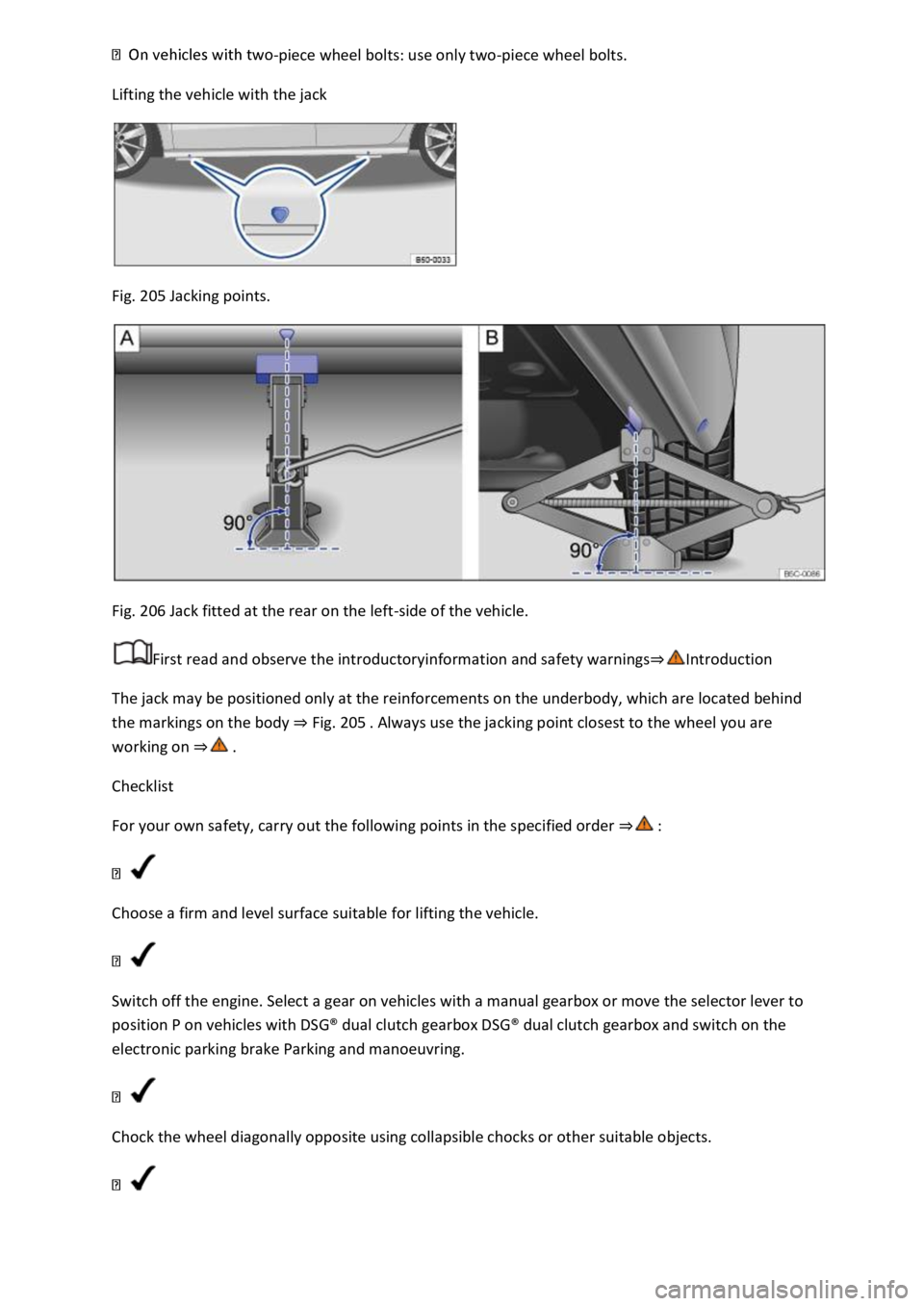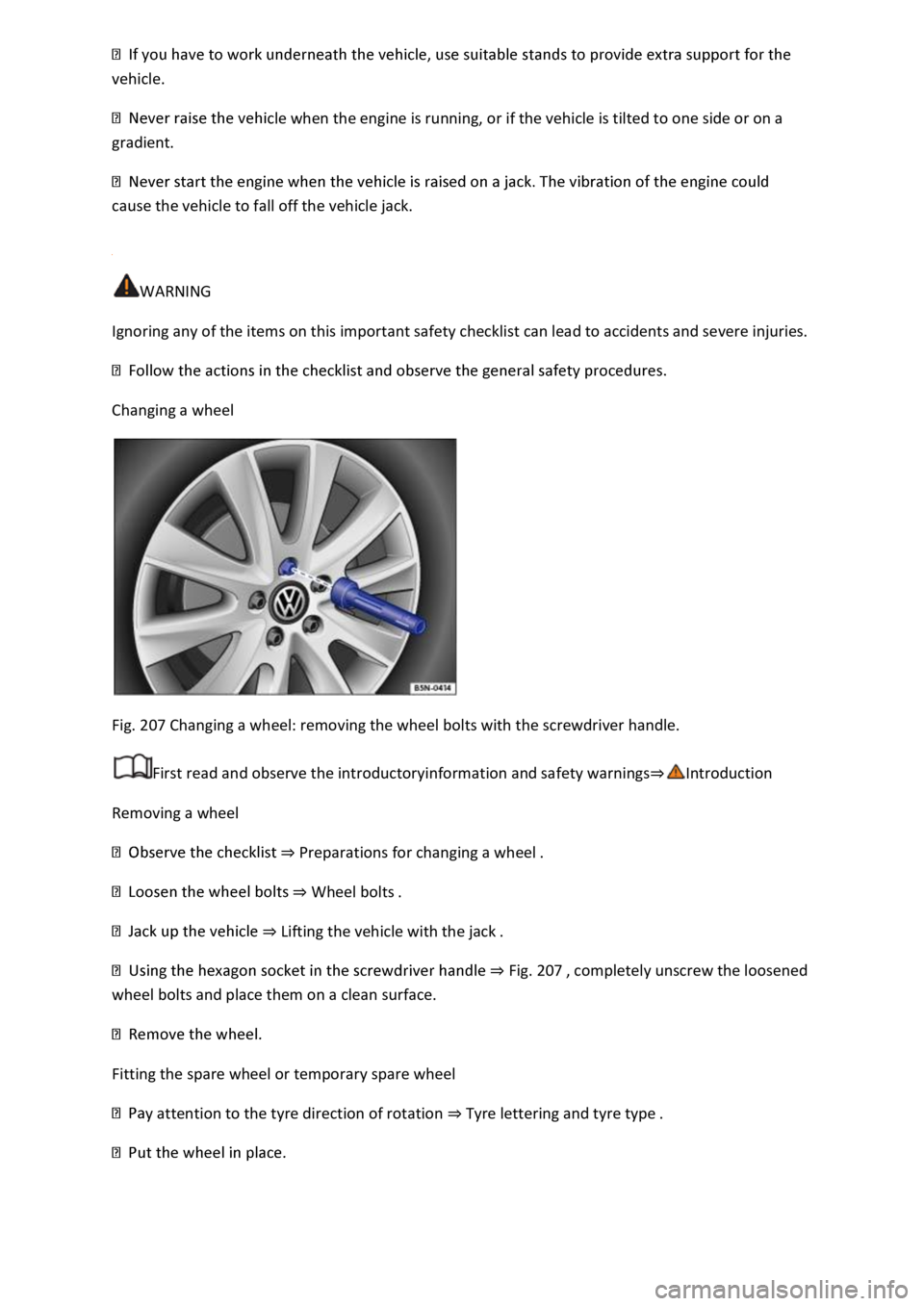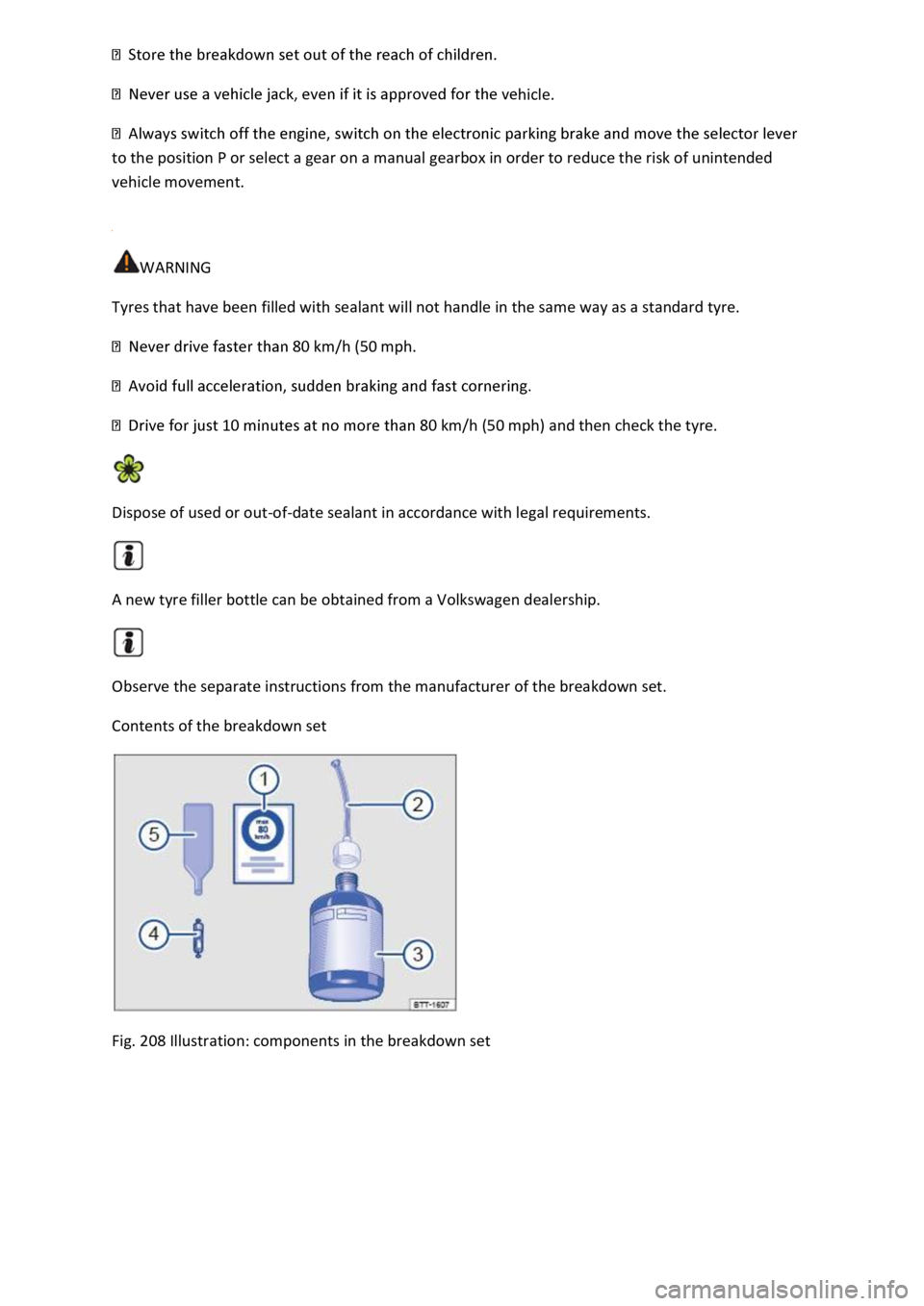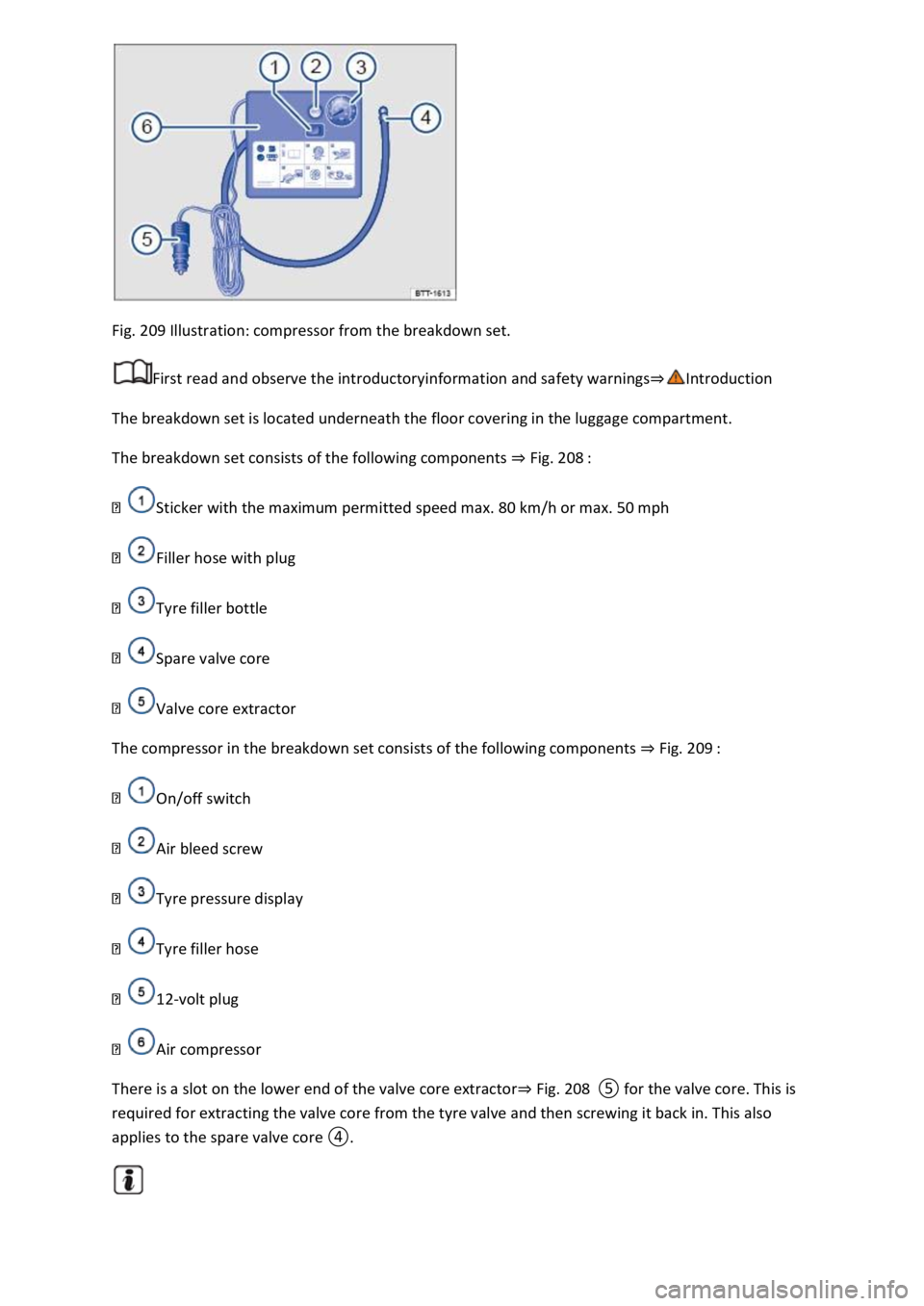VOLKSWAGEN T-ROC 2020 Owners Manual
Manufacturer: VOLKSWAGEN, Model Year: 2020, Model line: T-ROC, Model: VOLKSWAGEN T-ROC 2020Pages: 502, PDF Size: 8.58 MB
Page 421 of 502

piece wheel bolts: use only two-piece wheel bolts.
Lifting the vehicle with the jack
Fig. 205 Jacking points.
Fig. 206 Jack fitted at the rear on the left-side of the vehicle.
First read and observe the introductoryinformation and safety warnings
The jack may be positioned only at the reinforcements on the underbody, which are located behind
the markings on the body Fig. 205
working on
Checklist
For your own safety, carry out the following points in the specified order
Choose a firm and level surface suitable for lifting the vehicle.
Switch off the engine. Select a gear on vehicles with a manual gearbox or move the selector lever to
position P on vehicles with DSG
Page 422 of 502

Loosen the wheel bolts Wheel bolts.
Find the jacking point under the vehicle which is closest to the wheel that is being changed.
Insert the crank into the opening on the jack (depends on the vehicle equipment).
Crank up the jack until it just fits under the jacking point of the vehicle.
Ensure that the entire surface of the foot of the jack is resting securely on the floor, and that the
foot of the jack is positioned fully underneath the point of application and .
Position the jack and simultaneously continue to crank the claw up until it is in position around the
vertical rib underneath the vehicle .
Crank the jack further until the wheel is just clear of the ground.
WARNING
Incorrect use of the vehicle jack could cause the vehicle to slip off the jack. This could lead to severe
injuries. Observe the following points in order to reduce the risk of injuries:
jacks could slip out of position this includes vehicle jacks supplied with other Volkswagen models.
the vehicle to slip off the jack. If necessary, use a large, sturdy board or similar support for the
vehicle jack.
side member securely Fig. 206
lace any part of your body (e.g. an arm or leg) underneath the vehicle if the latter is
supported only by the vehicle jack.
Page 423 of 502

cle when the engine is running, or if the vehicle is tilted to one side or on a
gradient.
cause the vehicle to fall off the vehicle jack.
WARNING
Ignoring any of the items on this important safety checklist can lead to accidents and severe injuries.
Changing a wheel
Fig. 207 Changing a wheel: removing the wheel bolts with the screwdriver handle.
First read and observe the introductoryinformation and safety warnings
Removing a wheel
Preparations for changing a wheel
Wheel bolts
Lifting the vehicle with the jack
Fig. 207
wheel bolts and place them on a clean surface.
Fitting the spare wheel or temporary spare wheel
y attention to the tyre direction of rotation Tyre lettering and tyre type
Page 424 of 502

theft wheel bolt using the adapter at position Fig.
0
l the other wheel bolts in clockwise direction and tighten them slightly.
tighten the bolts in order but always in diagonally opposite sequence.
Hubcaps
WARNING
Incorrect tightening torque or incorrect use of wheel bolts can lead to a loss of control of the vehicle,
and cause accidents and serious injuries.
ep all wheel bolts and threads in the wheel hubs clean and free from oil and grease. The
wheel bolts must be easy to turn and be tightened to the specified torque.
not use
for loosening or tightening them.
After changing a wheel
First read and observe the introductoryinformation and safety warnings
luggage compartment Vehicle toolkit
Tightening torque of wheel
bolts
as possible.
After changing a wheel, the indicator lamp for the tyre monitoring system may indicate a fault in the
system T
Breakdown set
Introduction
This chapter contains information on the followingsubjects:
Contents of the breakdown set
Preparations
Sealing and inflating tyres
Page 425 of 502

Check after driving for 10 minutes
The breakdown set can be used to temporarily and reliably seal any tyre damage caused by foreign
bodies or punctures (up to approx. 4 mm in diameter). Do not remove foreign objects (e.g. screws or
nails) from the tyre!
Once the sealant has been added to the tyre, the tyre pressure must be checked and adjusted again
after approximately 10 minutes of driving.
Seek expert assistance if more than one of the vehicle's tyres is damaged. The breakdown set is
designed to fill only one tyre.
Only use the breakdown set when the vehicle has been safely parked and you are familiar with the
work and safety precautions needed. Seek expert assistance if this is not the case.
The tyre sealant must not be used:
-20
Page 426 of 502

hicle.
to the position P or select a gear on a manual gearbox in order to reduce the risk of unintended
vehicle movement.
WARNING
Tyres that have been filled with sealant will not handle in the same way as a standard tyre.
km/h (50 mph.
km/h (50 mph) and then check the tyre.
Dispose of used or out-of-date sealant in accordance with legal requirements.
A new tyre filler bottle can be obtained from a Volkswagen dealership.
Observe the separate instructions from the manufacturer of the breakdown set.
Contents of the breakdown set
Fig. 208 Illustration: components in the breakdown set
Page 427 of 502

Fig. 209 Illustration: compressor from the breakdown set.
First read and observe the introductoryinformation and safety warnings
The breakdown set is located underneath the floor covering in the luggage compartment.
The breakdown set consists of the following components Fig. 208
Sticker with the maximum permitted speed max. 80 km/h or max. 50 mph
Filler hose with plug
Tyre filler bottle
Spare valve core
Valve core extractor
The compressor in the breakdown set consists of the following components Fig. 209
On/off switch
Air bleed screw
Tyre pressure display
Tyre filler hose
12-volt plug
Air compressor
There is a slot on the lower end of the valve core extractorFig. 208
applies to the spare valve core
Page 428 of 502

set may be operated from the 12-volt socket, even if the
power rating on the type plate of the air compressor exceeds the maximum power rating of the
socket.
Preparations
First read and observe the introductoryinformation and safety warnings
Checklist
Always carry out the following actions in the given order
If your vehicle has a flat tyre, park the vehicle on a firm and level surface at a safe distance from
moving traffic.
Switch on the electronic parking brake Parking and manoeuvring.
DSG
Page 429 of 502

Take the breakdown set out of the luggage compartment.
Take the sticker
Do not remove foreign objects (e.g. screws or nails) from the tyre.
WARNING
Ignoring any of the items on this important safety checklist can lead to accidents and severe injuries.
Sealing and inflating tyres
First read and observe the introductoryinformation and safety warnings
Sealing a tyre
Fig.
0to unscrew the valve core from the tyre valve. Place
the core on a clean surface.
Fig.
0vigorously to and fro several times.
Fig.
0tightly onto the tyre filler bottle in a clockwise direction. The
plastic foil on the closure is pierced automatically.
Fig.
0and place the open end fully on the tyre valve.
Fig.
0to screw the valve core back into the tyre valve.
Inflating the tyre
Fig.
Fig.
0is closed.
-volt plug Fig.
0into one of the vehicle's 12-volt sockets Electrical sockets
Page 430 of 502

Fig.
0to switch on the air compressor.
2.5 bar (29 36 psi/200
250 kPa) unning time: 8 minutes
2.5 bar (29 36 psi/200 250 kPa) cannot be achieved, unscrew the tyre
filler hose from the tyre valve.
metres forward or back so that the sealing compound is evenly
distributed in the tyre.
again.
. The tyre cannot be
sealed with the breakdown set. Do not drive on. Seek expert assistance
km/h (50 mph) if a tyre pressure of 2.0 2.5 bar (29
36 psi/200 250 kPa) has been reached.
minutesCheck after driving for 10 minutes
WARNING
The tyre filler hose and the air compressor can get hot during inflation.
r hands and skin from the hot components.
bar (29 psi/200 kPa), the tyre is too damaged. The sealant
is unable to seal the tyre. Do not drive on. Seek expert assistance.
NOTICE
Switch the air compressor off after a maximum of 8 minutes to avoid overheating. Let the air
compressor cool down for a few minutes before switching it back on.
Check after driving for 10 minutes
First read and observe the introductoryinformation and safety warnings
Reconnect the tyre filler hose Fig.
0and read off the tyre pressure on the tyre pressure
1.3 bar (19 psi/130 kPa) and lower: